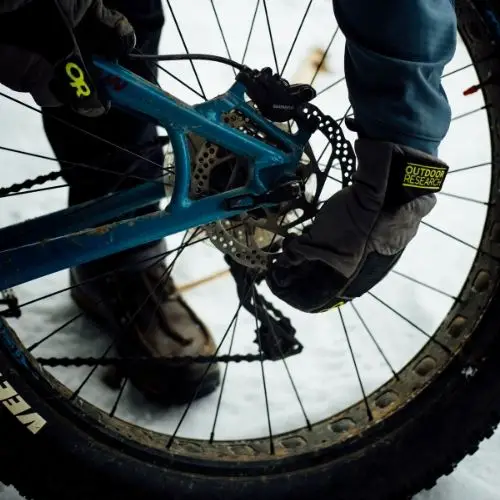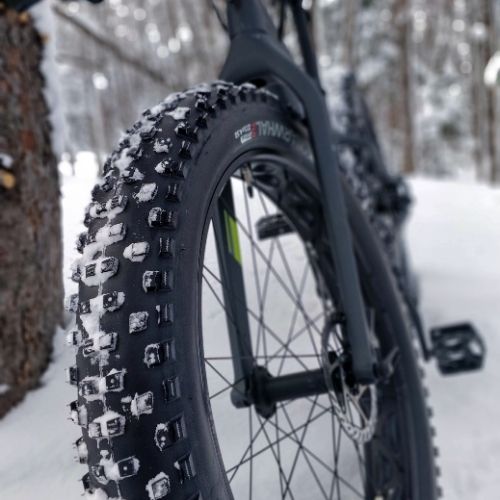If you are asking this question, then you have probably noticed that most modern mountain bikes are missing a front derailleur, and some manufacturers are still producing them, leaving Mountain bike riders the choice to have it set or not.
So why don’t mountain bikes have a front derailleur? SRAM, a well-known bicycle component manufacturer, started the trend of “No front derailleur” by producing in 2012 a range system “1X ” or “One by” drivetrains, dispensing the need of a second and third chainrings arrangement. This makes shifting considerably easier when going quickly on trails.
What’s a 1X system, and how does it replace front mechs on MTBs?

A drivetrain is the setting of parts and bits that allow bikes to move, such as chainrings, cassettes, brackets, and derailleurs.
A 1X system or drivetrain is a group set containing only one frontal chainring or sprocket instead of two or three. This means that there is no longer a need for a front derailleur or shifter, and the chain would stay on the same chainring the whole ride.
Furthermore, a one-by has only one gear shifter, on the handlebar, for the rear derailleur, controlling the back chain wheels. Thanks to the evolution of engineering, the structure of drivetrains has been modernized, and all the gear that was ditched from older productions was replaced with a Wide-range cassette in the back.
Wide range cassettes are the main component in 1X drivetrains. They’re a set of overlaid sprockets (chainrings), from the most significant (Low rings) on the inside to the smallest on the top layer (High rings).
The overlapping of chainrings offers the cassette a wide range of gear to give riders command over the intensity and speed during the ride.
The high gears, with the smallest circumference and fewer teeth, allow you to pedal at speed, like in a descent, whereas the lower gear (larger disks) makes it easier for you to climb, all in one cassette, which means less effort, and less material.
Is it worth upgrading not having a front derailleur ?
Like every revolutionary innovation, dropping your front derailleur and upgrading to a 1X drivetrain has its’ for and against.
One of the advantages of switching into a one-by is the new simple and easy-to-handle structure of the latest designs. By dropping a front derailleur, shifter, and cable, you will only have to rely on your right thumb to control the rear shifter, which is very easy to handle, and more suitable for beginners.
Furthermore, this architecture gained popularity for making the bikes lighter. Ditching material means less weight and less space used by material. This allowed companies to come up with renewed designs for their bikes and optimize manufacturing. Chains are produced to have more robust rings thanks to constant research. They stick to the cassette tight without any screeching noise.
These technologies grant lower accident rates. With the one chain setting and no front derailleur, bikes no longer shift chains, which causes them to fall off on multiple occasions. Most notably, in a one-by drivetrain, less material means less maintenance for damaged components.

On the other hand, the upgrade does have a cost; 1X systems are more expensive than 2X( two front chainrings), 3X(three front chainrings) drivetrains for similar qualities.
Additionally, the gearing range ( ratio between the fastest and the slowest gear) in two and three-by settings offer a more wide span, with fewer disks in the cassette thanks to the additional front chainrings; this issue can easily be fixed in 1X drivetrains if you get additional disks for your cassette, and combine them with the correct number of teeth in chainrings.
This solution brings us to another con of 1X sets. The more disks your cassette has, the weaker your wheel becomes because of severe chain angle, which causes it to wear off sooner.
And finally, the 1X architecture uses up to 14 cassette sprockets to increase gear range. For example, a 1X12 set is built with one chainring and 11 disks making 12 gears, while a 3X10 set has three chainrings up front, and ten cogs in the back, a total of 30 gears. The difference is pretty straightforward.
- Gearing Up: 5 Benefits of Having Fewer Gears on Your Mountain Bike
- Here’s how often you should be cleaning your Bicycle Chain
- 3 Reasons Bike Manufacturers Sell Expensive Chains: Are they worth it?
Frequently Asked Questions
Front derailleurs are not dead by any means! In fact many riders that switched to a 1X are now slowly moving back towards using a front derailleur again. That said, it is up to personal preference, and what you want out of your bicycle.
Expensive bikes tend to have less gears, because they have a more refined experience! Expensive bikes are also generally bought by more experienced riders that know that just because you have more gears, doesn’t mean you have a better bike.
A 21 speed bike means you have 21 increments of gearing. This means you can fluctuate how hard your pedaling is going to be. The faster you go, the higher the gear. The slower you go, the lower the gear you are going to choose.
If you just have to pull your front derailleur off of your bike for some reason, and then need to ride it, it will actually work! Don’t expect to shift gears at all in the front, but you will be able to ride no problem.
Conclusion
Modern mountain bikes have no front derailleurs because manufacturers are dropping the 2X and 3X drivetrains for the 1X one, and choosing which type of setting to ride is up to you.
On two and three-bys, the front gear will help you keep consistency while climbing up, so one-bys are for stronger riders. On the other hand, a 1X arrangement is probably safer to run down a hill than the other, so there isn’t a winner. It depends on what type of rider you are.














